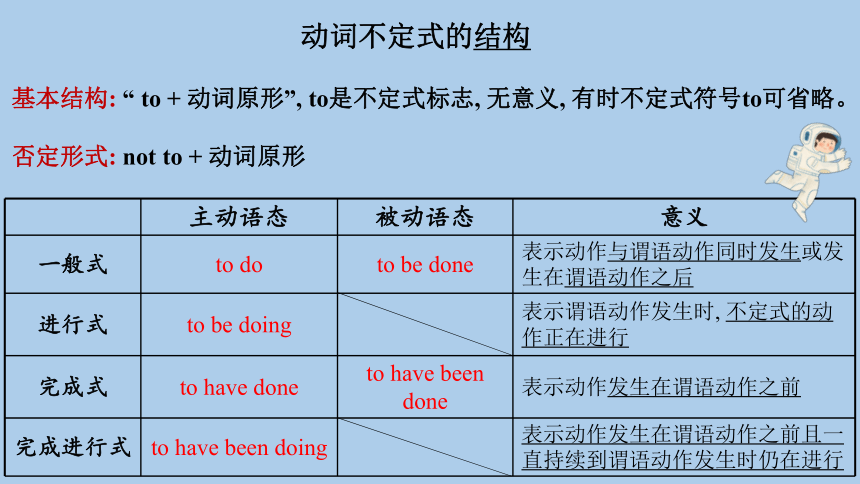人教版(2019)必修 第三册Unit 4 Space Exploration动词不定式作定语和状语 课件(20张PPT)
文档属性
| 名称 | 人教版(2019)必修 第三册Unit 4 Space Exploration动词不定式作定语和状语 课件(20张PPT) |

|
|
| 格式 | pptx | ||
| 文件大小 | 5.7MB | ||
| 资源类型 | 教案 | ||
| 版本资源 | 人教版(2019) | ||
| 科目 | 英语 | ||
| 更新时间 | 2023-06-11 22:35:29 | ||
图片预览









文档简介
(共20张PPT)
Unit 4 Discovering Useful Structures
-动词不定式作定语和状语
To live abroad is not easy.
She planned to visit her parents next week.
The question is how to get there.
The first person to come is Mr. Brown.
He went to France to learn French.
His father encouraged him to find a new job.
主语
宾补
状语
观察下面句子并分析划线部分在句中所作的成分。
宾语
表语
定语
动词不定式是非谓语动词的一种, 没有人称和数的变化, 在句中不能独立作谓语。
动词不定式既有名词、形容词和副词的某些语法功能, 又有动词的时态和语态的特点及作用, 在句中可以作主语、宾语、表语、宾语补足语、定语和状语。
一、动词不定式
主动语态 被动语态 意义
一般式 to do to be done 表示动作与谓语动作同时发生或发生在谓语动作之后
进行式 to be doing 表示谓语动作发生时, 不定式的动作正在进行
完成式 to have done to have been done 表示动作发生在谓语动作之前
完成进行式 to have been doing 表示动作发生在谓语动作之前且一直持续到谓语动作发生时仍在进行
基本结构: “ to + 动词原形”, to是不定式标志, 无意义, 有时不定式符号to可省略。
否定形式: not to + 动词原形
动词不定式的结构
=We must find a person who can do the homework.
We must find a person to do the homework.
动词不定式作定语, 一般放在被修饰的名词、代词的后面, 多表示将来的动作, 可转化为定语从句。
二、动词不定式作定语
构成动词不定式的动词与被修饰词之间的关系
We must find a person to do the homework.
There are lots of interesting things to see.
I have no time to go there.
They got the order to leave the city.
动词不定式作定语, 不定式和它所修饰的名词之间有逻辑上的主谓关系、动宾关系、动状关系或同位关系。
主谓关系(主动)
动宾关系(被动)
同位关系
动状关系
动词不定式作定语的情况
1. 当名词被序数词、形容词最高级或the only, the next, the last, the right, the best修饰, 常用动词不定式作定语。该名词为不定式的执行者时, 用动词不定式主动形式, 名词为不定式的承受者时, 用to be done(被动形式)。
You are the only person to be late.
This is the third question to be discussed.
In the past, women had no chance to go to school.
The ability to express an idea is as important as the idea itself.
2. 当被修饰词是抽象名词时, 常用动词不定式作定语。常见的该类名词有: ability, chance, idea, hope, wish, fact, promise, attempt, way等。
3. 当修饰的词为something, nothing, anything等不定代词时, 常用动词不定式作定语。
Do you have anything to say
There is nothing to worry about.
I want to get something to drink.
1. 作定语的动词不定式如果是不及物动词, 或者不定式所修饰的名词或代词是不定式动作的地点、工具等, 不定式后面须有相应的介词。
The Browns have a comfortable house to live in.
Here is some paper for you to write on.
特别提醒
2. 当动词不定式与被修饰的词有动宾关系, 且和句中的主语构成逻辑上的主谓关系时, 该不定式通常用主动形式表示被动意义; 如果没有逻辑上的主谓关系且不确定逻辑主语是谁是, 则不定式应使用被动形式。
I have something to type.
Boss, do you have anything to be typed
特别提醒
动词不定式在句中作状语, 主要用来修饰动词、形容词、副词等, 表示目的、原因、结果等。
在句中, 不定式可作目的状语、结果状语、原因状语等。
三、动词不定式作状语
意为 “为了”, 可位于句首或句末, 置于句首时常表示强调。为加强语气, 不定式前也可加in order或so as, 但so as to不能用于句首。
To pass the college entrance exam, we must work hard.
He promised to make all efforts in order to/so as to help us.
1. 动词不定式作目的状语
常与only, enough或too连用, 用于“too...to”;“enough to ...”;“only to do” (表示意料之外的结果); “so/such…as to” 结构句中。
(1) too ... to + do “太…而不能做…”
(2) adj/adv + enough to do “足以去做…”
(3) only to + do (find/discover/realize)
(4) so + adj/adv + as to do 或such + n + as to do “如此…以至于…”。
2. 动词不定式作结果状语
He woke up to find himself alone in the house.
He went back home, only to find his house had been broken into.
He is old enough to go to school.
She is so proud as to look down upon others.
2. 动词不定式作结果状语
He went home to find his old friend George outside the door.
The child fell, striking his head against the door and cutting it.
动词不定式作结果状语强调的是一种意想不到的结果;
现在分词作结果状语强调的是一种顺承的, 必然造成的结果。
不定式与现在分词作结果状语的区别
She is proud to have won the first place.
He is glad to be invited to the meeting.
We were astonished to find the temple still in its original condition.
(1) 常用于“sb. + be + adj. + to do”结构中, 形容词作表语时, 后可接不定式作原因状语, 用以说明产生这种情绪的原因。此类形容词多是sorry, glad, excited, disappointed, shocked等表示喜怒哀乐的形容词。
3. 动词不定式作原因状语
The morning air is so good to breathe that he gets up early every day.
(2) 常用于“sth. + be + adj. + to do”结构中, 这类形容词有easy, difficult, hard, cheap, expensive, comfortable, good, important, impossible, dangerous等, 表示主语的特征或性质, 不定式和句子主语之间存在动宾关系, 但常用主动形式表示被动意义。
4. 动词不定式作方式状语
He opened his mouth as if to say something.
She lifts his hand as if to lead him somewhere.
主要用于 as if to do sth 结构。
THANKS
Unit 4 Discovering Useful Structures
-动词不定式作定语和状语
To live abroad is not easy.
She planned to visit her parents next week.
The question is how to get there.
The first person to come is Mr. Brown.
He went to France to learn French.
His father encouraged him to find a new job.
主语
宾补
状语
观察下面句子并分析划线部分在句中所作的成分。
宾语
表语
定语
动词不定式是非谓语动词的一种, 没有人称和数的变化, 在句中不能独立作谓语。
动词不定式既有名词、形容词和副词的某些语法功能, 又有动词的时态和语态的特点及作用, 在句中可以作主语、宾语、表语、宾语补足语、定语和状语。
一、动词不定式
主动语态 被动语态 意义
一般式 to do to be done 表示动作与谓语动作同时发生或发生在谓语动作之后
进行式 to be doing 表示谓语动作发生时, 不定式的动作正在进行
完成式 to have done to have been done 表示动作发生在谓语动作之前
完成进行式 to have been doing 表示动作发生在谓语动作之前且一直持续到谓语动作发生时仍在进行
基本结构: “ to + 动词原形”, to是不定式标志, 无意义, 有时不定式符号to可省略。
否定形式: not to + 动词原形
动词不定式的结构
=We must find a person who can do the homework.
We must find a person to do the homework.
动词不定式作定语, 一般放在被修饰的名词、代词的后面, 多表示将来的动作, 可转化为定语从句。
二、动词不定式作定语
构成动词不定式的动词与被修饰词之间的关系
We must find a person to do the homework.
There are lots of interesting things to see.
I have no time to go there.
They got the order to leave the city.
动词不定式作定语, 不定式和它所修饰的名词之间有逻辑上的主谓关系、动宾关系、动状关系或同位关系。
主谓关系(主动)
动宾关系(被动)
同位关系
动状关系
动词不定式作定语的情况
1. 当名词被序数词、形容词最高级或the only, the next, the last, the right, the best修饰, 常用动词不定式作定语。该名词为不定式的执行者时, 用动词不定式主动形式, 名词为不定式的承受者时, 用to be done(被动形式)。
You are the only person to be late.
This is the third question to be discussed.
In the past, women had no chance to go to school.
The ability to express an idea is as important as the idea itself.
2. 当被修饰词是抽象名词时, 常用动词不定式作定语。常见的该类名词有: ability, chance, idea, hope, wish, fact, promise, attempt, way等。
3. 当修饰的词为something, nothing, anything等不定代词时, 常用动词不定式作定语。
Do you have anything to say
There is nothing to worry about.
I want to get something to drink.
1. 作定语的动词不定式如果是不及物动词, 或者不定式所修饰的名词或代词是不定式动作的地点、工具等, 不定式后面须有相应的介词。
The Browns have a comfortable house to live in.
Here is some paper for you to write on.
特别提醒
2. 当动词不定式与被修饰的词有动宾关系, 且和句中的主语构成逻辑上的主谓关系时, 该不定式通常用主动形式表示被动意义; 如果没有逻辑上的主谓关系且不确定逻辑主语是谁是, 则不定式应使用被动形式。
I have something to type.
Boss, do you have anything to be typed
特别提醒
动词不定式在句中作状语, 主要用来修饰动词、形容词、副词等, 表示目的、原因、结果等。
在句中, 不定式可作目的状语、结果状语、原因状语等。
三、动词不定式作状语
意为 “为了”, 可位于句首或句末, 置于句首时常表示强调。为加强语气, 不定式前也可加in order或so as, 但so as to不能用于句首。
To pass the college entrance exam, we must work hard.
He promised to make all efforts in order to/so as to help us.
1. 动词不定式作目的状语
常与only, enough或too连用, 用于“too...to”;“enough to ...”;“only to do” (表示意料之外的结果); “so/such…as to” 结构句中。
(1) too ... to + do “太…而不能做…”
(2) adj/adv + enough to do “足以去做…”
(3) only to + do (find/discover/realize)
(4) so + adj/adv + as to do 或such + n + as to do “如此…以至于…”。
2. 动词不定式作结果状语
He woke up to find himself alone in the house.
He went back home, only to find his house had been broken into.
He is old enough to go to school.
She is so proud as to look down upon others.
2. 动词不定式作结果状语
He went home to find his old friend George outside the door.
The child fell, striking his head against the door and cutting it.
动词不定式作结果状语强调的是一种意想不到的结果;
现在分词作结果状语强调的是一种顺承的, 必然造成的结果。
不定式与现在分词作结果状语的区别
She is proud to have won the first place.
He is glad to be invited to the meeting.
We were astonished to find the temple still in its original condition.
(1) 常用于“sb. + be + adj. + to do”结构中, 形容词作表语时, 后可接不定式作原因状语, 用以说明产生这种情绪的原因。此类形容词多是sorry, glad, excited, disappointed, shocked等表示喜怒哀乐的形容词。
3. 动词不定式作原因状语
The morning air is so good to breathe that he gets up early every day.
(2) 常用于“sth. + be + adj. + to do”结构中, 这类形容词有easy, difficult, hard, cheap, expensive, comfortable, good, important, impossible, dangerous等, 表示主语的特征或性质, 不定式和句子主语之间存在动宾关系, 但常用主动形式表示被动意义。
4. 动词不定式作方式状语
He opened his mouth as if to say something.
She lifts his hand as if to lead him somewhere.
主要用于 as if to do sth 结构。
THANKS
